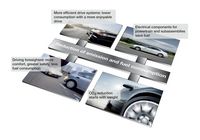Continental Brings Together Four Strategies to Reduce Emissions and Cut Fuel Consumption
FRANKFURT AM MAIN/REGENSBURG, July 22, 2009: Lowering the fuel consumption and emissions of cars and commercial vehicles is one of the most important issues for the future of sustainable individual mobility worldwide. The Automotive Group of the international automotive supplier Continental is bringing together four strategies to reduce fuel consumption, and will be able to offer motor manufacturers a comprehensive package of solutions for the low-consumption vehicles demanded by the market. These measures will also ensure compliance with national and international legislative requirements for emissions standards and the reduction of CO2.
"Our goal of enabling resource-efficient motoring with a reduced environmental impact cannot be achieved through individual measures alone. It requires a number of intelligent innovations that cover the full range of systems“, said Dr. Karl-Thomas Neumann, Chief Executive Officer of Continental AG and Head of the Automotive Group. "These innovations also have to be scalable, so that they can be offered in price-sensitive vehicle classes and markets."
Continental AG's Automotive Group is focusing on four complementary strategies to reduce the impact of vehicles on the environment and to ensure the sustainable use of resources. This integrated systems approach will help car manufacturers to bring vehicles to market that maximize fuel economy while minimizing environmental impact.
More efficient drive systems: lower consumption with a more enjoyable
drive
Continental's turbocharger is now in use for the first time.
This new technology is an essential prerequisite for the "downsizing" of
engines, i.e. a lower cubic capacity but with greater power. Clever
innovations include the automated assembly and the electronically
controlled wastegate that will be available in the future. The turbocharger
technology can cut emissions by up to 15 percent.
New direct-drive piezo injectors ensure that even diesel engines comply with the Euro 6 standard, while the SCR system for exhaust gas aftertreatment helps to achieve the required reduction in nitrogen oxide. High-performance transmission control systems reduce the fuel consumption of automatic double-clutch transmissions to below that of manual gearboxes.
Electrical components for powertrain and subassemblies save
fuel
The transition from internal combustion engine to the
zero-emission electric car of the future is already well underway. A
representative survey of German motorists carried out on behalf of
Continental in spring 2009 showed that nearly one in nine car drivers can
"entirely" imagine switching to an electric car for their next vehicle.
"The stated aim of Continental is to consolidate its leading position as a supplier in this field," stressed Dr. Neumann. Continental is the world's first manufacturer of series production lithium-ion batteries for use in passenger cars and commercial vehicles. With its modular hybrid approach, Continental covers all essential components and offers complete system solutions. The replacement of conventional hydraulic technology with electrically powered ancillary components, which only consume energy when it is actually required, also cuts fuel consumption. To take power steering as an example, the use of an electric system can save around 0.2-0.4 liters of fuel per 100 kilometers compared with the hydraulic version. Intelligent battery sensors ensure that the battery is only charged when required - reducing the workload of the engine and decreasing fuel consumption - and also take over the electrics management for stop-start systems which are now coming to market in a large number of vehicle models.
Driving foresighted: more comfort, greater safety, lower fuel
consumption
Driver assistance systems not only make driving more
comfortable and safer, but also help the driver to drive more smoothly and
more pro-actively, thus saving fuel. The Accelerator Force Feedback Pedal
(AFFP) is a good example of an intuitive driver-vehicle interface.
A light vibration of the accelerator pedal reminds the driver to keep a safe distance from the vehicle in front, even in heavy traffic, and to maintain as constant a speed as possible. It also tells him the ideal time to change gear, which can achieve fuel savings in excess of ten percent.
Navigation systems also help to reduce energy consumption. They facilitate driving electric cars by automatically planning the route according to the available battery charging or battery changing stations. The "electronic horizon" based on the navigation information provides information on the road ahead to all other onboard systems, such as engine control and battery management.
CO2 reduction starts with weight
Lightweight design makes it
possible to reduce vehicle weight: designs which reduce weight and use less
material achieve similar effects as the use of lighter materials, which are
still prohibitively expensive for many vehicle classes and markets.
Optimized housing for braking systems or ESC weigh up to 20 percent less,
while aluminum brake actuators can cut weight by as much as 40 percent.
Last, but not least: the crucial role of the driver
And
finally, it is important that the driver is also fully committed to the
idea of fuel economy. This can be achieved by providing clear information
about what kind of emissions savings the vehicle is capable of, and by
means of a central control setting that enables the driver to switch all
vehicle systems to an energy-efficient or fuel-efficient operating mode.
This approach from the Continental Automotive Group is called „
Simplify your Drive."



